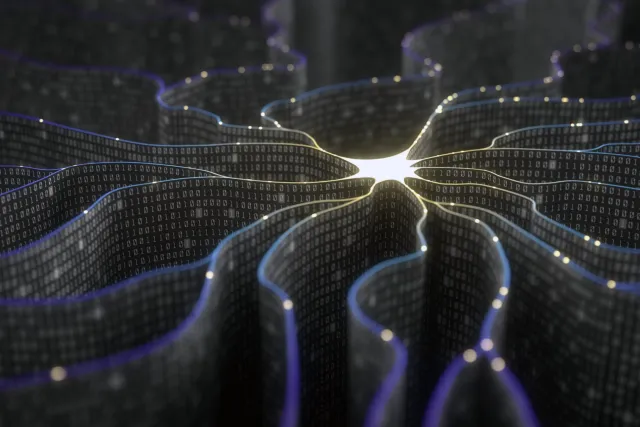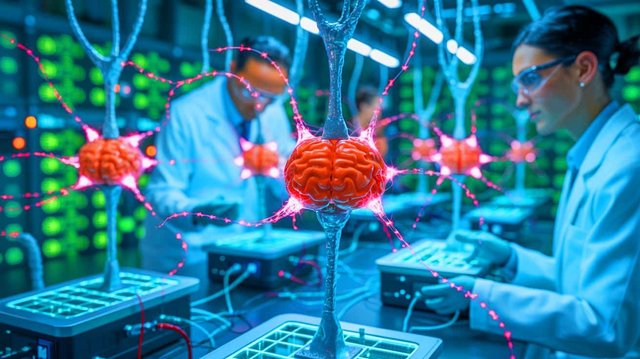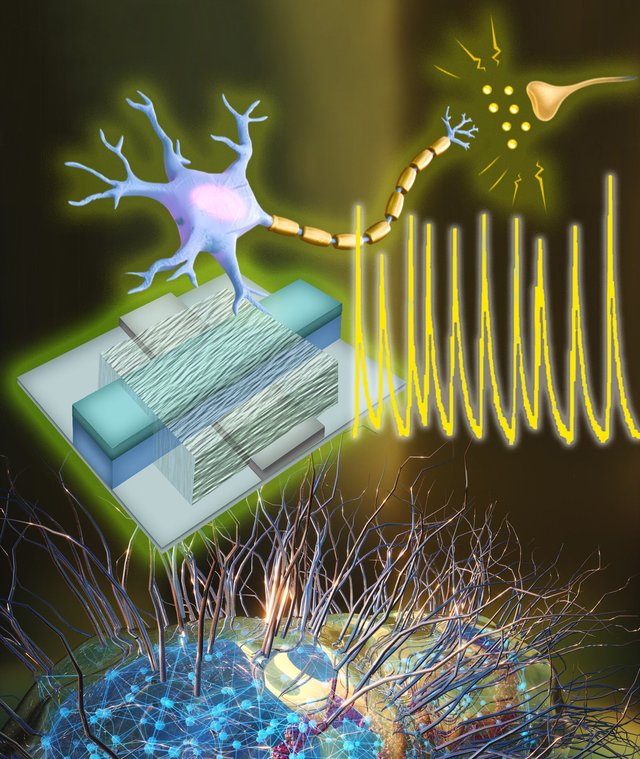Scientists create artificial neurons that function like real ones/Científicos crean neuronas artificiales que funcionan como las reales

Source
The spectacularly rapid advances in artificial intelligence and robotics seem to suggest that, in the not-too-distant future, humans will go from being the kings of creation to just another creature to make documentaries about. In this scenario, it seems that the only serious alternative to our extinction would be to merge with machines in order to control them. Along these lines, new artificial neurons that can fire, learn, and communicate using chemical and electrical signals, just like the natural neurons in the human brain, will make our task easier.
El avance espectacularmente rápido de la inteligencia artificial y de la robótica parece sugerir que, en un futuro no muy lejano, los humanos pasaremos de ser los reyes de la creación a ser un puto bicho más para hacer documentales. En este escenario parece que la única alternativa seria a nuestra extinción sería fusionarnos con las máquinas para llegar a controlarlas. En esta línea, las nuevas neuronas artificiales que pueden disparar, aprender y comunicarse utilizando señales químicas y eléctricas, exactamente como las neuronas naturales del cerebro humano, nos facilitarán la tarea.
A team of researchers at the University of Massachusetts Amherst has developed artificial neurons that replicate the function of human nerve cells with remarkably low energy efficiency and voltage similar to those of real neurons. This means they can interact directly with living tissue efficiently and without the need for complex electrical amplification systems. This allows these electronic devices to communicate naturally with human cells, opening the door to new generations of brain-machine interfaces.
Un equipo investigadores de la Universidad de Massachusetts Amherst, ha desarrollado neuronas artificiales que replican la función de las células nerviosas humanas con una eficiencia energética y un voltaje notablemente bajos, similares a los de las neuronas reales, lo que significa que pueden interactuar directamente con tejidos vivos de forma eficiente y sin necesidad de complejos sistemas de amplificación eléctrica. Esto permite que estos dispositivos electrónicos se comuniquen de manera natural con las células humanas, abriendo la puerta a nuevas generaciones de interfaces cerebro-máquina.

Source
Thanks to their low energy consumption and their ability to “sense” and interpret neurotransmitters and other chemical signals, these advances pave the way for a more fluid and stable fusion between biological and technological systems, something that was very difficult with previous technologies that used much more energy or could not adequately mimic neural chemistry. The key component to achieve this efficiency are protein nanowires synthesized from a bacterium (Geobacter sulfurreducens), which is known to produce electricity.
Gracias a su bajo consumo energético y su capacidad de “sentir” e interpretar neurotransmisores y otras señales químicas, estos avances allanan el camino hacia una fusión más fluida y estable entre sistemas biológicos y tecnológicos, algo que era muy difícil con tecnologías previas que usaban mucha más energía o no podían imitar adecuadamente la química neural. El componente clave para lograr esta eficiencia son los nanocables de proteínas sintetizados a partir de una bacteria (la Geobacter sulfurreducens), que es conocida por producir electricidad.
These nanowires are integrated with an electronic component called a memristor (a resistor with memory). The combination of these materials allows artificial neurons to generate repeatable voltage spikes (action potentials), which is how real neurons transmit information, and respond to chemical signals (such as neurotransmitters or drugs) by adjusting their firing rate. Scientists have shown that these artificial neurons can communicate with living biological cells, such as heart muscle cells, and even influence their rhythm.
Estos nanocables se integran con un componente electrónico llamado memristor (una resistencia con memoria). La combinación de estos materiales permite que las neuronas artificiales generen picos de voltaje repetibles (potenciales de acción), que es la forma en que las neuronas reales transmiten información y respondan a señales químicas (como neurotransmisores o medicamentos), ajustando su ritmo de activación.Los científicos han demostrado que estas neuronas artificiales pueden comunicarse con células biológicas vivas, como células de músculo cardíaco, e incluso influir en su ritmo.

Source
At first glance, this technology has the potential to create robotic prosthetics that are controlled more intuitively and naturally by the user's intentions. If the artificial neurons are integrated with the residual nerves, the prosthesis could not only receive commands from the brain but also send sensory information (such as touch or temperature) back to the nervous system, closing the loop. Devices equipped with these artificial neurons could act as artificial synaptic bridges for brain regions damaged by diseases (such as Alzheimer's or Parkinson's) or injuries.
A bote pronto, esta tecnología tiene un potencial de crear prótesis robóticas que se controlan de manera más intuitiva y natural con la intención del usuario. Si las neuronas artificiales se integran con los nervios residuales, la prótesis podría no solo recibir comandos del cerebro, sino también enviar información sensorial (como tacto o temperatura) de vuelta al sistema nervioso, cerrando el ciclo. Los dispositivos equipados con estas neuronas artificiales podrían actuar como puentes sinápticos artificiales para regiones cerebrales dañadas por enfermedades (como el Alzheimer o el Parkinson) o lesiones.
Unfortunately, the development of these biomimetic artificial neurons is in a very promising preclinical research stage, but they are not yet ready for widespread use in hospitals. Integrating any artificial component into the brain's network of trillions of connections is an engineering challenge that goes beyond having a single functional neuron. But the technology has been shown to work at a fundamental level, and the basic "building block" for a secure bidirectional interface is designed, so that, possibly within a decade, we mortals will be able to enjoy these advances.
Lamentablemente, el desarrollo de estas neuronas artificiales biomiméticas está en una etapa de investigación preclínica muy prometedora, pero aún no están listas para su uso masivo en hospitales. Integrar cualquier componente artificial en la red de billones de conexiones del cerebro es un desafío de ingeniería que va más allá de tener una sola neurona funcional. Pero se ha demostrado que la tecnología funciona a nivel fundamental y que el "ladrillo" básico para una interfaz bidireccional segura está diseñado así que, posiblemente en una década podamos disfrutar los mortales de estos avances.
More information/Más información
https://newatlas.com/medical-tech/artificial-neuron-mimic-reality-bioelectronics/
https://www.dw.com/es/crean-neuronas-artificiales-que-funcionan-como-las-reales/a-74430214